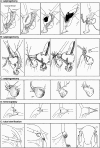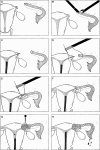Experience of laparoscopic tubal surgery at the department of obstetrics and gynecology, University of Kiel, from 1999 through 2000
- PMID: 15554276
- PMCID: PMC3016828
Experience of laparoscopic tubal surgery at the department of obstetrics and gynecology, University of Kiel, from 1999 through 2000
Abstract
Objective: We analyzed the results of laparoscopic tubal surgery performed at the Department of Obstetrics and Gynaecology, University of Kiel, between 1999 and 2000. A retrospective review of 236 tubal surgical procedures was conducted: (1) patients with ectopic pregnancies, unilateral or bilateral tubal occlusions or alterations and (2) medically indicated sterilizations and salpingectomies.
Methods: Two specialists and 10 gynecologists in residency training performed the following 236 procedures: 64 salpingotomies, 74 salpingectomies, 25 salpingostomies, 8 tubal end-to-end anastomoses, 24 fimbrioplasties, and 41 tubal sterilizations. In June 2001, questionnaires were sent to all 236 patients who underwent laparoscopic tubal surgery to evaluate subsequent pregnancies. From the 195 answers received, 155 patients wished to have children and of these 79 (51%) became pregnant. In 8 tubal reversals, 6 pregnancies occurred, resulting in a 75% success rate. In the group of sterilizations and salpingectomies, no pregnancies occurred.
Results: A pregnancy rate of 51% resulted after tubal reconstructive surgery. After tubal sterilization, no pregnancies were observed in the following 3 years.
Conclusion: Laparoscopic tubal surgery has surpassed laparotomic tubal surgery with comparable success rates. Laparoscopic tubal surgery is also a less traumatic procedure.
Figures


Similar articles
-
Laparoscopic surgery of the fallopian tubes and ovaries.Semin Laparosc Surg. 1999 Jun;6(2):58-67. doi: 10.1053/SLAS00600058. Semin Laparosc Surg. 1999. PMID: 10459057 Review.
-
Laparoscopy or laparotomy for distal tubal surgery? A meta-analysis.Hum Fertil (Camb). 2007 Mar;10(1):43-7. doi: 10.1080/14647270600977820. Hum Fertil (Camb). 2007. PMID: 17454208
-
Complications of female sterilization: immediate and delayed.Fertil Steril. 1984 Mar;41(3):337-55. doi: 10.1016/s0015-0282(16)47709-5. Fertil Steril. 1984. PMID: 6230257
-
Laparoscopic microsurgical anastomosis of the blocked, solitary post-ectopic Fallopian tube: case report.Hum Reprod. 2002 Jun;17(6):1630-2. doi: 10.1093/humrep/17.6.1630. Hum Reprod. 2002. PMID: 12042289
-
Laparoscopic Management of 42 Cases of Tubal Stump Pregnancy and Postoperative Reproductive Outcomes.J Minim Invasive Gynecol. 2020 Mar-Apr;27(3):618-624. doi: 10.1016/j.jmig.2019.04.030. Epub 2019 Nov 12. J Minim Invasive Gynecol. 2020. PMID: 31726111
Cited by
-
Ruptured Recurrent Interstitial Ectopic Pregnancy Successfully Managed by Laparoscopy.Diagnostics (Basel). 2024 Feb 27;14(5):506. doi: 10.3390/diagnostics14050506. Diagnostics (Basel). 2024. PMID: 38472978 Free PMC article.
References
-
- Cohen MR. The role of culdoscopy in infertility. Am J Obstet Gynecol. 1959;78:266–273 - PubMed
-
- Semm K. Zur technik der eileiterdurchblasung. 2. Geburtsh Gyna¨k Beilageheft. 1964;162:48–53
-
- Frangenheim H. Die tubensterilisation unter sicht mit dem laparoskop. Geburtshilfe und Frauenheilkunde. 1964;24:470. - PubMed
-
- Semm K. Die laparoskopie in der gyna¨kologie. Geburtshilfe und Frauenheilkunde. 1967;27:1029. - PubMed
-
- Mettler L, Giesel H, Semm K. Treatment of female infertility due to tubal obstruction by operative laparoscopy. Fertil Steril. 1979;32:384–388 - PubMed
MeSH terms
LinkOut - more resources
Full Text Sources
